By Roy Smith
In Part 1, Barn Find, and Part 2 Glass Dreams Smith described the Rédélé barn find, the relationship to Jean Rédélé, Zark W. Reed, Renault Rosier and the search for the elusive Fiberglas car called “Marquis”. Part 3 explains how everything went badly for Reed and how Porsche-Meister Bob Holbert played a part in this incredible story.
Shattered Dreams
Unknown to all parties, Reed was being poorly advised by the men he had recruited to put the “Marquis”, the name they had given to the proposed fiber glass car, into production. A former Chief Design Engineer at Ford who had joined PlastiCar was not up to the mark, and he and his colleagues got off to a bad start. They found it difficult to full appreciate the concept of the rear-engine design which they would have on the Marquis, planned to be a direct copy of the Rédélé “Renault Special” which would be made after the Rogue. The 4CV engine layout was one they were not familiar with and the enthusiastic Zark had already ordered 150 initial chassis floor pans from Renault. In addition, the team used many layers of the impregnated glass wool and as a result the first Rogue body was too thick…hardly the thing for a lightweight sports car. This may have been intentional; according to current Rogue owner Todd Daniel, it is possible that the bodies were made this way as they were prototypes, and weight was not a consideration for the initial two bodies.
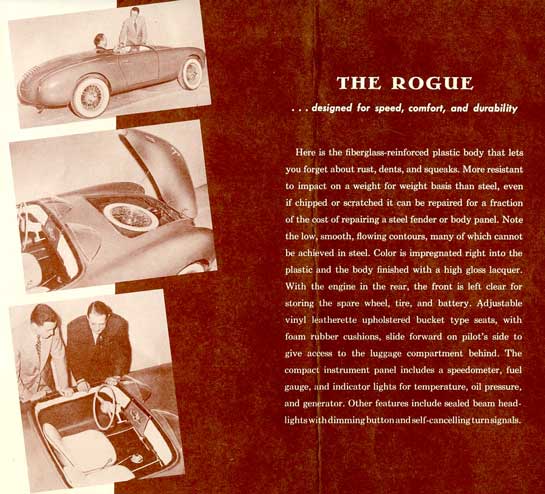
A page from the Rogue brochure. The features listed were color impregnated fiberglas, finished in high gloss lacquer, rear engine, vinyl bucket seats, compact instrument panel, and sealed beam headlights with dimming button!
According to Daniel, the main problem was that the engineers did not install all of the stock Renault engine compartment shroudings, which caused poor air flow. In addition, the cars had to meet the federal and state requirements for road gear such as seven inch sealed beam headlights, bumpers, windshields and windshield wipers.
Whatever happened, Reed suddenly found himself with a unsalable product. To make matters worse, he was now facing the same problem with the planned (and much more complex) Marquis coupé, plus he had a bill for 50 million francs from Renault for the mechanical assemblies. He had also taken the drive train from the Rédélé car to put in the Rogue! Disaster was at hand.
Jean Rédélé soon heard about the problems and after his 750cc class victory with Louis Pons in the ’54 Mille Miglia with a 4CV, he went to Pennsylvania but was horrified to find that what he had heard was true and he could only confirm the fiasco to Renault during his visit. Furious that parts of his car had been used in the Rogue and the fact that no body mold for the new car had been made, he could see his licensee was failing and cancelled the agreement. It was all over. He returned to France with no money from the deal. Nor did Rédélé take the Special number 2 as it was too expensive to ship back. No doubt Rédélé was also anxious to recover from what one might see as a humiliation.
As for the Marquis and PlastiCar Inc of Doylestown, Pennsylvania, USA, the only glass-fiber-bodied car they did create was the one based on the Rosier design that they called the Rogue.
And what of the Marquis? The Marquis was never actually put in production. What had happened to the New York Show car remained a mystery until the previously mentioned Marvin McFalls started to investigate. He found that the Rédélé aluminum car held by Zark Reed’s PlastiCar Company had been put up for sale. Not surprising in itself, but what would happen next most certainly was.
Enter Bob Holbert
Bob Holbert hailed from Warrenton, Pennsylvania and was one of the most successful Porsche drivers in the 1950s and 60s. His career included class wins at Le Mans and Sebring, three time winner of the “Number One Driver Award” by the New York Times, Sports Illustrated “Driver of the Year”, and numerous class and overall wins with Porsches and Cobras. When he began racing in 1953, Holbert piloted a series of MGs with considerable success in SCCA events. By 1954-5 he was looking for something a bit more modern. He had established a Volkswagen-Porsche dealership in Warrenton (a suburb of Philadelphia) but would not own a Porsche 550 Spyder until the beginning of 1957. In the interim loomed the strange French car possibly titled as a “Marquis”.
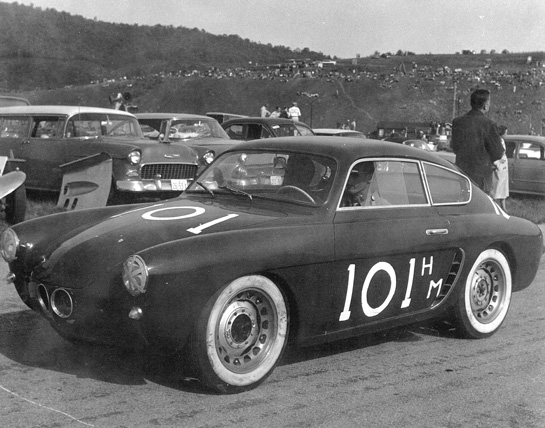
May 20, 1956. The Rédélé Special number 2 is ready for its first competition at Cumberland. Photo courtesy Larry Holbert.
According to an article by Ted West in Vintage Motorsport,Holbert was at the New York Auto Show and on an impulse, bought what West described as a “Renault Marquis Modified”. In another interview for the magazine, Sports Car Guide March 1960, the authors state that the Renault was purchased after the New York Auto Show in 1956.
An accurate date was provided by the excellent “Racing Sports Cars” website. A complete list of racing results for Bob Holbert included the mention of the entry of a “Marquis” at Cumberland on May 20th, 1956, the car’s one and only competition appearance. Todd Daniel, (see below) had a chance to talk to Bob Holbert about the purchase years ago. “He said his partner purchased the car from a used car lot in 1955-56 sans motor. He put a motor in it.”
It was not a great experience. Holbert remembered the car for Sports Car Guide in 1960. “…I didn’t keep it long. Worked on the Renault for six weeks, then ran it once at Cumberland [Maryland]. When it wouldn’t stay pasted together I sold it. Specials can be a real headache.”
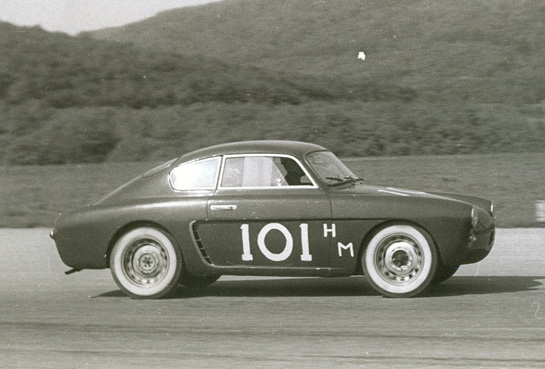
Bob Holbert out on the track with the car he bought at the New York Auto Show. He probably was unaware at the time that the car was actually built by Jean Rédélé. Photo courtesy Larry Holbert.
Marvin McFalls was on to the Holbert connection as he researched the story as well. McFalls had two photos of the Rédélé at Cumberland. When I sent them to VeloceToday, the Editor sent the photos on to Carl Goodwin, a historian with close contacts with the Holbert family, having written about Holbert in his book “They Started in MGs” https://velocetoday.com/book-review-they-started-in-mgs/ Carl in turn sent the photos to Larry Holbert, Bob’s son, who responded with confirmation, references and two more excellent photos of the Marquis of Mystery at Cumberland on May 20, 1955. It was entered in the H Modified Class, meaning that the engine was no more than 750cc.
McFalls also thinks that when purchased, the car was less engine and drivetrain and that Holbert had fitted a different engine. This would explain the time it took to get ready for the track. (Parts from Europe took FOREVER to get to the States in those days).
Full Circle
Four decades later, an American Renault Club member was asked about a car that a gentleman wanted to restore. McFalls identified it as looking like the long-lost Marquis. Eureka! Maybe? After a lot of research, McFalls had found something even more interesting and more valuable. It was not a Marquis, nor a Marquis Modified, nor a Renault Marquis, but the long-lost car Jean Rédélé could not afford to bring back to France in 1955 after the failure of the Zark Reed Marquis project.
Mary Ann Wood remembered when her father bought the car:
“My father, Raymond Buckwalter, was a keen collector of cars. He had a Lincoln dealership and had access to lots of cars. Sometime around 1957 he was told about an interesting little coupé for sale. He bought it and used it – it was running ok until it failed to start, then I got to use it.
It had an all-aluminium body, Renault engine and had been in our barn for as long as I can remember. A local garage man tried to get it running but he said there is a problem with the carburetor that was not resolvable.”
Back to you, Rédélé
The late Raymond Buckwalter couldn’t have known how important a car his purchase was to become, and after many months of negotiations with the owner in the U.S.A., in 2011 the car was purchased by the Rédélé family in France. It therefore returned to its birth place to rest in the collection of Jean Charles Rédélé who would exhibit it at the 2012 Retromobile classis show in Paris on February 1st.
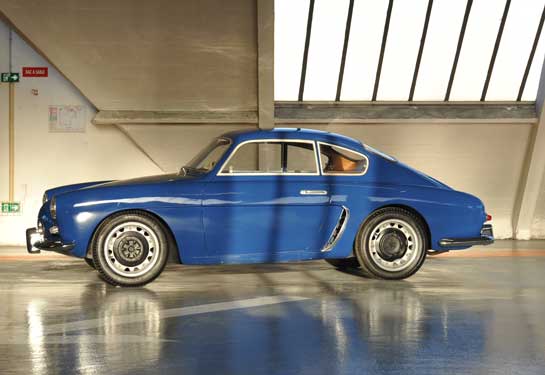
Now back in France, the Rédélé Special number 2 has gone full circle with a truly remarkable story and heritage. Courtesy Jean Jacques Mancel of berlinette magazine.
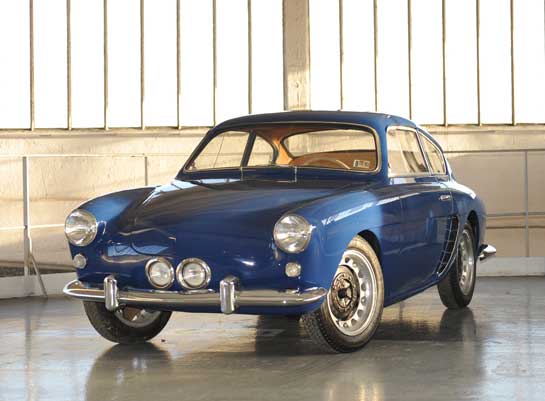
The Rédélé made an appearance at this year’s Retromobile in Paris. Courtesy Jean Jacques Mancel of berlinette magazine.
Special thanks to Carl Goodwin, Larry Holbert, Todd Daniel Thierry Falsetti and Jean Jacques Mancel of “BERLINETTE Magazine.”.
Roy Smith is the author of several books about the Alpine company. In 2012 he’ll have published a work on the life of Gordini and in 2013 a work entitled “Alpine Renault- the fabulous berlinettes”. Portions of this three part story appeared in the French “BERLINETTE Magazine” magazine.
Addendum: Where are they today?
Rédélé Special Number 1: The car that won the Dieppe Rally and was instumental in the career of Jean Redele, according to Thierry Falsetti (www.AlpineRenault.com), is still missing despite many attempts to find it.
Rédélé Special Number 2: As above, now back in France with the Rédélé family.
The Rogue: the original PlastiCar, still exists in the collection of Todd Daniel. Upon reading the first two parts of the Marquis story, Daniel emailed us with his surprising story. “My car is the car shown at the New York International Car Show and has many driveline parts from the Marquis. A second Rogue exists which was used as a buck for production molds and used as one of the 75 chassis assemblies that came from Renault directly. This car is now with Jeff Lane at his museum in Nashville.”
There is more to this story and we hope to bring you more about the efforts to resurrect the Rogue in a future edition of VeloceToday.
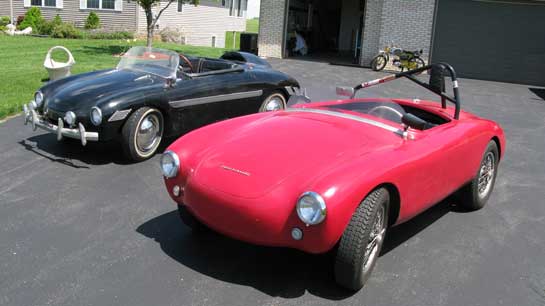
Todd Daniel's red Rogue sits next to the second example, now with the Jeff Lane Museum. Photo courtesy Todd Daniels.
The Renault 1068 Spyder, aka Rosier: Built in conjunction with Renault by the great French father and son team of Loius and Jean-Louis Rosier for the 1953 Le Mans, the car is reported to have been destroyed in 1962. This was apparently confirmed by Louis Rosier’s grandson, per Todd Daniel. In addition, we mistakenly stated that the Rosier was a front engine special (information found in the book “Le Mans, 1949-1959” by Quentin Spurring). According to Daniel the Rosier car was “… built on a 4CV chassis by Motto of Turin After the car was presented to Renault and Rosier in this form from Motto, it was prepared and modified for Le Mans at the Renault factory. The Borrani wheels were replaced with a factory star wheels and the radiator for the watercooled rear engine was moved to the front of the car requiring the front air intake in the nose.”
The Marquis: It never existed.
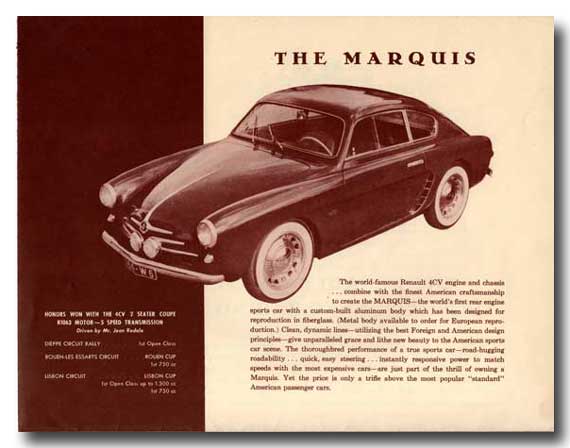
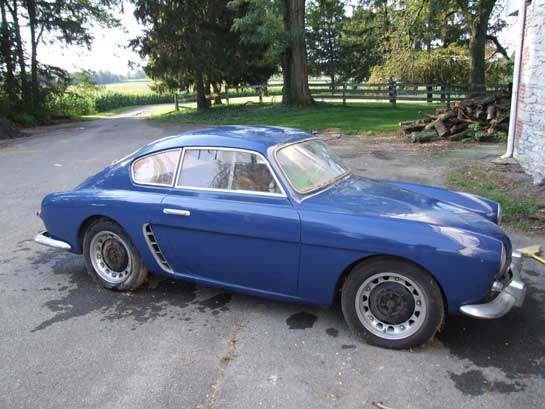
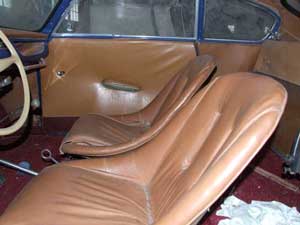
The dural wheels on the Redele special II came from the Renault parts bin, where I got the ones for my Alpine 106. Cooling was also a problem with the alpine, when it was at speed on a racecourse. It is, however, better looking than the little Alpine.
Hello,
One Redele spécial is missing the number 3.
I show this to Thierry Falsetti and Jean Luc Fournier.
And gave us data which confirm this.
In their article you could find this research
Hello,
The marquis is the name of the number 2 car, the one which goes to US and was present to a car show.
the number 3 is in the collection of a french owner and it is not the one which is in the collection of Jean Charles Redele.
Best Regards